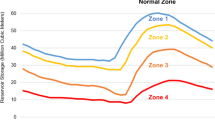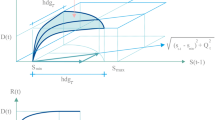Abstract
This study proposed a simple and efficient method for developing time-varying discrete hedging rules. The novelty of the proposed methodology is that long-range streamflow traces are inserted into the sequent peak processes in order to reflect long-lasting drought events, which is rarely considered, during the development of the hedging rules. The developed rules were evaluated with three performance indices (risk, resiliency, and vulnerability) across a wide range of synthetic streamflow scenarios that represent changes in the annual mean streamflow and the long-range streamflow dependency. Boryung Dam, located in South Korea, was used as a case study. As a result, the developed hedging rules reflecting long-range streamflow traces led to enhanced reservoir operation performance results in terms of resiliency and vulnerability indices. The developed hedging rules outperformed the reference hedging rules, especially under dry conditions. When there was a strong long-range dependency in streamflow, the superiority of the developed hedging rules was found to be remarkable. Since the proposed methodology is relatively simple, it will be easy for dam operators to understand and implement discrete hedging rules at different sites.








Similar content being viewed by others
References
Bayazit M, Ünal NE (1990) Effects of hedging on reservoir performance. Water Resour Res 26(4):713–719
Efstratiadis A, Dialynas YG, Kozanis S, Koutsoyiannis D (2014) A multivariate stochastic model for the generation of synthetic time series at multiple time scales reproducing long-term persistence. Environ Model Softw 62:139–152. https://doi.org/10.1016/j.envsoft.2014.08.017
Eum HI, Kim Y-O, Palmer RN (2010) Optimal drought management using sampling stochastic dynamic programming with a hedging rule. J Water Resour Plan Manag 137(1):113–122
Fraedrich K, Larnder C (1993) Scaling regimes of composite rainfall time series. Tellus A: Dynamic Meteorology and Oceanography 45(4):289–298
Graves T, Gramacy R, Watkins N, Franzke C (2017) A brief history of long memory: Hurst, Mandelbrot and the road to ARFIMA, 1951-1980. Entropy 19(9):1–21. https://doi.org/10.3390/e19090437
Hashimoto T, Stedinger JR, Loucks DP (1982) Reliability, resiliency, and vulnerability criteria for water resource system performance evaluation. Water Resour Res 18(1):14–20. https://doi.org/10.1029/WR018i001p00014
Heim RR Jr (2002) A review of twentieth-century drought indices used in the United States. Bull Am Meteorol Soc 83(8):1149–1165
Hosking JRM (1984) Modeling persistence in hydrological time series using fractional differencing. Water Resour Res 20(12):1898–1908. https://doi.org/10.1029/WR020i012p01898
Houck MH, Cohon JL, ReVelle CS (1980) Linear decision rule in reservoir design and management: 6. Incorporation of economic efficiency benefits and hydroelectric energy generation. Water Resour Res 16(1):196–200
Huang WC, Chou CC (2005) Drought early warning system in reservoir operation: theory and practice. Water Resour Res 41(11):W11406. https://doi.org/10.1029/2004WR003830
Hurst HE (1951) Long-term storage capacity of reservoirs. Trans Am Soc Civ Eng 116:770–808
Iliopoulou T, Papalexiou SM, Markonis Y, Koutsoyiannis D (2018) Revisiting long-range dependence in annual precipitation. J Hydrol 556:891–900. https://doi.org/10.1016/j.jhydrol.2016.04.015
Karamouz M, Imen S, Nazif S (2012) Development of a demand driven hydro-climatic model for drought planning. Water Resour Manag 26(2):329–357. https://doi.org/10.1007/s11269-011-9920-0
Klemeš V (1977) Value of information in reservoir optimization. Water Resour Res 13(5):837–850
Koutsoyiannis D (2003) Climate change, the Hurst phenomenon, and hydrological statistics. Hydrol Sci J 48(1):3–24
Koutsoyiannis D (2011) Hurst-Kolmogorov dynamics and uncertainty. J Am Water Resour Assoc 47(3):481–495. https://doi.org/10.1111/j.1752-1688.2011.00543.x
Lund JR (1996) Developing seasonal and long-term reservoir system operation plans using HEC-PRM (No. HEC-RD-40). Hydrologic Engineering Center, Davis
Neelakantan TR, Pundarikanthan NV (1999) Hedging rule optimisation for water supply reservoirs system. Water Resour Manag 13(6):409–426
Neelakantan TR, Pundarikanthan NV (2000) Neural network-based simulation-optimization model for reservoir operation. J Water Resour Plan Manag 126(2):57–64
O’Connell PE, Koutsoyiannis D, Lins HF, Markonis Y, Montanari A, Cohn T (2016) The scientific legacy of Harold Edwin Hurst (1880–1978). Hydrol Sci J 61(9):1571–1590. https://doi.org/10.1080/02626667.2015.1125998
Pelletier JD (1998) The power spectral density of atmospheric temperature from time scales of 10− 2 to 106 yr. Earth Planet Sci Lett 158(3–4):157–164
Pelletier JD, Turcotte DL (1997) Long-range persistence in climatological and hydrological time series: analysis, modeling and application to drought hazard assessment. J Hydrol 203(1–4):198–208
Potter KW (1978) Sequent peak procedure: minimum reservoir capacity subject to constraint on final storage. JAWRA Journal of the American Water Resources Association 14(4):991–993. https://doi.org/10.1111/j.1752-1688.1978.tb05595.x
Sandoval-Solis S, McKinney DC, Loucks DP (2010) Sustainability index for water resources planning and management. J Water Resour Plan Manag 137(5):381–390
Seo SB, Mahinthakumar G, Sankarasubramanian A, Kumar M (2018a) Conjunctive management of surface water and groundwater resources under drought conditions using a fully coupled hydrological model. J Water Resour Plan Manag 144(9):04018060
Seo SB, Mahinthakumar G, Sankarasubramanian A, Kumar M (2018b) Assessing the restoration time of surface water and groundwater systems under groundwater pumping. Stoch Env Res Risk A 32(9):2741–2759
Shepherd A (1998) Drought contingency planning: evaluating the effectiveness of plans. J Water Resour Plan Manag 124(5):246–251. https://doi.org/10.1061/(ASCE)0733-9496(1998)124:5(246)
Shiau JT (2003) Water release policy effects on the shortage characteristics for the Shihmen reservoir system during droughts. Water Resour Manag 17(6):463–480. https://doi.org/10.1023/B:WARM.0000004958.93250.8a
Shih JS, ReVelle C (1995) Water supply operations during drought: a discrete hedging rule. Eur J Oper Res 82(1):163–175
Srinivasan K, Philipose MC (1998) Effect of hedging on over-year reservoir performance. Water Resour Manag 12(2):95–120
Stephenson DB, Pavan V, Bojariu R (2000) Is the North Atlantic oscillation a random walk? Int J Climatol 20(1):1–18
Thomas HA Jr, Burden RP (1963) Operations research in water quality management. Harvard University Press, Cambridge
Tu MY, Hsu NS, Yeh WWG (2003) Optimization of reservoir management and operation with hedging rules. J Water Resour Plan Manag 129(2):86–97
Acknowledgments
This research has been supported by a grant (NRF-2017R1A6A3A11031800) obtained through the Young Researchers program funded by the National Research Foundation of Korea. This work also has been supported by a grant (18AWMP-B083066-05) through the Korea Environmental Industry & Technology Institute funded by the Ministry of Environment. The authors thank the support of the Institute of Engineering Research, Seoul National University.
Author information
Authors and Affiliations
Corresponding author
Ethics declarations
Conflict of Interest
The authors declare that they have no conflict of interest.
Additional information
Publisher’s Note
Springer Nature remains neutral with regard to jurisdictional claims in published maps and institutional affiliations.
Electronic supplementary material
ESM 1
(PDF 750 kb)
Rights and permissions
About this article
Cite this article
Seo, S.B., Kim, YO. & Kang, SU. Time-Varying Discrete Hedging Rules for Drought Contingency Plan Considering Long-Range Dependency in Streamflow. Water Resour Manage 33, 2791–2807 (2019). https://doi.org/10.1007/s11269-019-02244-5
Received:
Accepted:
Published:
Issue Date:
DOI: https://doi.org/10.1007/s11269-019-02244-5




